
Bon Ami (French for "Good Friend") is an American scouring powder brand sold by the Bon Ami Company of Kansas City, Missouri. Since its inception in the late 19th century, the brand's advertising campaigns have gained particular notice.

Bon Ami (French for "Good Friend") is an American scouring powder brand sold by the Bon Ami Company of Kansas City, Missouri. Since its inception in the late 19th century, the brand's advertising campaigns have gained particular notice.

The original Bon Ami formula was developed in 1886 by the J. T. Robertson Soap Company as a gentler alternative to quartz-based scouring powders available in stores. [1] [2] In those days, scouring powder was made from tallow and finely ground quartz. When quartz was mined, it was entwined with feldspar, and the two had to be separated by hand. [3] The feldspar was discarded until Robertson discovered that this soft mineral could be combined with soap to create a less-abrasive product that would clean without scratching, resulting in the Bon Ami product. [4]
Bon Ami was originally manufactured in a factory in Glastonbury, Connecticut, which later moved to Manchester in the 1880s. [5]
As of 1896, Bon Ami was a common product in northeastern United States households. [4] The slogan "hasn't scratched yet!" is an early American trademark. [6] [7] [8]
In the early 1900s, Alfred William Erickson, founder of McCann, revived the brand with full-color pages in leading women's magazines. He accepted Bon Ami as a client c. 1908. [9] Artist Ben Austrian painted the prints, [2] [3] and Ben's wife served as the model in the ads. The campaign blossomed into literature with the release of The Chick That Never Grew Up, a work of children's literature featuring Princess Bon Ami. [2]
In 1963, Lestoil purchased an approximately 60% stake in Bon Ami. [10] Bon Ami merged into Lestoil in 1964, after protracted negotiations. [11]
In 1971, Bon Ami was purchased by the Faultless Starch Company, [12] which later changed the corporation name to Faultless Starch/Bon Ami Company to help reintroduce Bon Ami to the market.
In 1980, the company again revived its brand with a magazine campaign featuring the headline "never underestimate the cleaning power of a 94-year-old chick with a French name". [8] During the first 6 months of the campaign, Bon Ami sales rose 12%. [13] Nevertheless, its business was still flagging by 1983, when it remained in third place behind products from Procter & Gamble and Colgate-Palmolive. [12]
In 2011, Bon Ami celebrated its 125th anniversary by rereleasing the original cleaning cake for purchase. Limited supplies were offered both with and without a commemorative tin, celebrating the original formula's popularity. [14]
The product called "original" contains only feldspar. [15] For other products, the Bon Ami website lists the following as main ingredients: feldspar, limestone, water, baking soda, citric acid, corn alcohol, epsom salts, essential oils, and xanthan gum. [16]

In the F. Scott Fitzgerald novel Tender Is the Night , first published in 1934, Fitzgerald notes the routine of the character Dick Diver in cleaning up his workroom at his home outside Cannes: "He swept up, for no servants were allowed in there, treated his washroom sketchily with Bon Ami, repaired a screen and sent off an order to a publishing house in Zurich". [17]
In the 1966 film The Ghost and Mr. Chicken , whenever discussing a murder at an old mansion, one character mentions that the police were unable to clean the blood off the organ keys, and another character adds, "And they used Bon Ami!" Lead actor Don Knotts personally got permission from the president of Bon Ami to include this reference to the company's product. [18]
In the first volume of his autobiography, Isaac Asimov recalls a box his family kept in the bathroom when he was a child, and how in his childish naïveté he was impressed that the company was so conscientious that if they ever found that the powder had scratched, they would change the slogan to "Only Scratched Once!" [19]
Jane Vandenburgh's novel Failure to Zigzag makes reference to Bon Ami's slogan "hasn't scratched yet". [20]

Soap is a salt of a fatty acid used for cleaning and lubricating products as well as other applications. In a domestic setting, soaps, specifically "toilet soaps", are surfactants usually used for washing, bathing, and other types of housekeeping. In industrial settings, soaps are used as thickeners, components of some lubricants, emulsifiers, and catalysts.
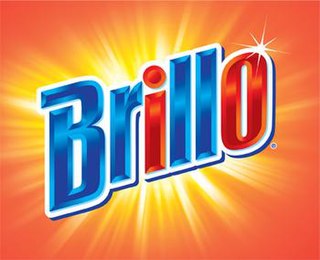
Brillo is a trade name for a scouring pad, used for cleaning dishes, and made from steel wool filled with soap. The concept was patented in 1913, at a time when aluminium pots and pans were replacing cast iron in the kitchen; the new cookware blackened easily. The company's website states the name Brillo is from the Latin word for "bright", although no such word exists in Latin. In Spanish the word brillo means the noun "shine"; however, German, Italian, French, and English do have words for "shine" or "bright" beginning with brill- deriving from Latin words for beryl.
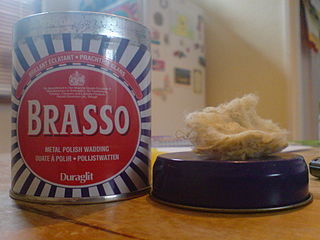
Brasso is a metal polish designed to remove tarnish from brass, copper, chrome and stainless steel. It is available either directly as a liquid or as an impregnated wadding pad also known as Duraglit.

Rinso is a brand name of laundry soap and detergent marketed by Unilever. The brand was created by Robert Spear Hudson and originally branded Hudson's Soap, which was sold to Lever Brothers of Port Sunlight, England, in 1908. It was introduced in the United States by Lever Brothers Company in 1918.

Tide is an American brand of laundry detergent manufactured and marketed by Procter & Gamble. Introduced in 1946, it is the highest-selling detergent brand in the world, with an estimated 14.3 percent of the global market.
Ivory is an American flagship personal care brand created by the Procter & Gamble Company (P&G), including varieties of white and mildly scented bar soap that became famous for its claim of purity and for floating on water. Over the years, the brand has been extended to other varieties and products.

Vim is the name of a range of household cleaning products originally produced by Lever Brothers. The Vim brand is currently owned by the German multinational company Henkel, while Unilever retains ownership in Canada and Vietnam.
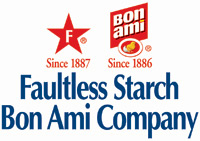
Faultless Brands is a manufacturing business, producing laundry, household cleaning products, air care, and lawn and garden products. The company headquarters are located in Kansas City, Missouri, United States.

Zest is an American brand of soap and body wash owned by High Ridge Brands for the United States, Canada and Puerto Rico and by Unilever for the rest of the world. It was originally introduced by Procter & Gamble in 1955 with the slogan "For the first time in your life, feel really clean."

Henkel AG & Co. KGaA, commonly known as Henkel, is a German multinational chemical and consumer goods company headquartered in Düsseldorf, Germany. Founded in 1876, the DAX company is organized into two globally operating business units and is known for brands such as Loctite, Persil, Fa, Pritt, Dial and Purex.

Ajax is an American brand of household cleaning products and detergents made by Colgate-Palmolive and Awesome Products Inc.

The economy of the Kansas City metropolitan area is anchored by Kansas City, Missouri, which is the largest city in the state and the 37th largest in the United States. The Kansas City metropolitan area is the 27th largest in the United States, based on the United States Census Bureau's 2004 population estimates. The metro's economy is large and influential to its region.
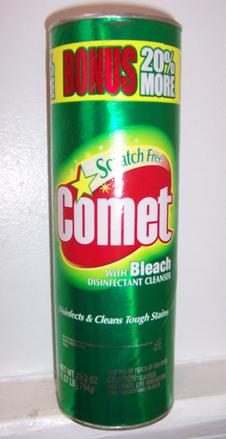
Comet is an American brand of scouring powders and other household cleaning products manufactured by KIK Custom Products Inc. The brand was introduced in 1956 by Procter & Gamble (P&G) and sold to Prestige Brands in 2001. In 2018, Prestige Brands sold the Comet brand to KIK Custom Products Inc. P&G retained the rights to market the brand in Europe and to the professional market (non-home-consumer) in the United States.

Colgate is an American brand principally used for oral hygiene products such as toothpastes, toothbrushes, mouthwashes and dental floss. Manufactured by Colgate-Palmolive, Colgate's oral hygiene products were first sold by the company in 1873, sixteen years after the death of the founder, William Colgate. The company originally sold soap.
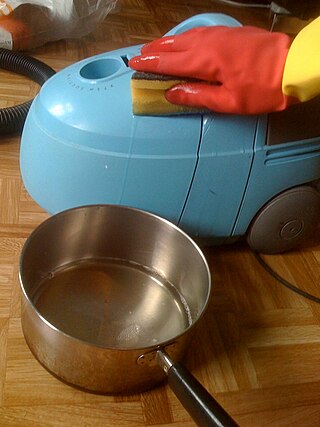
Cleaning agents or hard-surface cleaners are substances used to remove dirt, including dust, stains, foul odors, and clutter on surfaces. Purposes of cleaning agents include health, beauty, removing offensive odors, and avoiding the spread of dirt and contaminants to oneself and others. Some cleaning agents can kill bacteria and clean at the same time. Others, called degreasers, contain organic solvents to help dissolve oils and fats.

Bar Keepers Friend is an American brand of mass-produced cleaning agents. The original canned scouring powder product has been manufactured and sold since 1882. It was invented by a chemist in Indianapolis, Indiana, where it continues to be manufactured by SerVaas Laboratories. The canned product's primary active ingredient is oxalic acid. Bar Keepers Friend has various cleaning uses.

Fairbank's Gold Dust washing products was a line of all-purpose cleaning agents researched and developed by the N. K. Fairbank Manufacturing Company. First introduced to the American consumer in 1889, Gold Dust Washing Powder became a success due in large part to its low selling price and bright, eye-catching packaging. The most easily recognized members of the soap line were Gold Dust Washing Powder and Gold Dust Scouring Soap. They were marketed in boxes and containers prominently featuring the brand's well known trademark, the Gold Dust Twins. "Let the Twins Do Your Work" was the product's long lasting and ubiquitous slogan.

Lestoil is a registered trade name of Clorox for a heavy-duty multipurpose cleanser product, used to remove extremely difficult laundry stains, dissolve water-based and oil-based paints, and clean grease, oil, paint, and adhesives from floors and surfaces. It was introduced as a dry cleaning fluid for laundry in 1933. As a company, Lestoil, also known as the Adell Chemical Company, also made Bon Ami, from 1964 until 1971.
Scouring powder is a household cleaning product consisting of an abrasive powder mixed with a dry soap or detergent, soda, and possibly dry bleach.